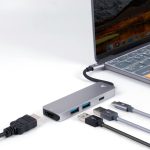A docking station simplifies your remote work by enhancing connectivity and reducing cable clutter, allowing you to connect multiple devices easily. It maximizes your screen real estate, boosting productivity with a dual monitor setup. You’ll also enjoy better ergonomics with properly positioned screens, promoting comfort and reducing strain. Plus, its sleek design keeps your workspace organized. Want to know more about how to choose the right docking station for your needs?
Table of Contents
Key Takeaways
- A docking station enables seamless connectivity between multiple devices, reducing setup time and eliminating cable clutter in remote workspaces.
- It supports dual monitor setups, enhancing productivity by allowing simultaneous use of multiple applications for efficient multitasking.
- Clear labeling of ports simplifies cable management, making it easy to connect and disconnect devices during remote work.
- Ergonomic positioning of monitors through docking stations promotes good posture and reduces the risk of strain injuries while working remotely.
- Compact and portable design makes docking stations ideal for remote work, allowing easy transport and organized workspace setups.
The Benefits of Using a Docking Station
When you set up your remote workspace, using a docking station can transform your experience. A docking station simplifies your setup by allowing you to connect multiple devices with just one cable.
This means you can quickly switch between your laptop and external monitors, keyboards, or mice without tangled cords slowing you down. It also boosts productivity, as you can easily expand your screen real estate and utilize larger displays for multitasking.
Plus, a docking station often provides additional ports for USB devices, making it easier to connect peripherals. With a more organized workspace, you’ll find it easier to focus and stay on task, ultimately enhancing your overall efficiency while working remotely.
Enhancing Connectivity and Compatibility
As you expand your remote workspace, enhancing connectivity and compatibility becomes essential for seamless operation. A docking station bridges the gap between multiple devices, allowing you to connect your laptop to various peripherals with ease.
You’ll appreciate the convenience of plugging in your keyboard, mouse, and printer all at once, instead of juggling cables. Additionally, most docking stations support a wide range of devices, ensuring that whether you’re using a Windows laptop, MacBook, or even a tablet, you can stay connected without hassle.
This compatibility not only simplifies your setup but also speeds up your workflow. With a reliable docking station, you’ll eliminate connectivity issues, enabling you to focus on your tasks and collaborate effectively with your team.
Maximizing Screen Real Estate
To truly maximize your screen real estate, consider setting up a dual monitor system.
This setup not only expands your workspace but also enhances your productivity by allowing you to multitask effortlessly.
Pair it with the right productivity tools, and you’ll transform the way you work remotely.
Dual Monitor Setup
Maximizing your screen real estate with a dual monitor setup can greatly enhance your productivity, especially for remote work.
With two screens, you can keep multiple applications open simultaneously, allowing you to multitask more efficiently. Imagine having your email on one screen while you work on a presentation on the other; it’s a game changer.
Connecting your monitors through a docking station simplifies this process, providing the necessary ports and power. You won’t have to deal with tangled cords or limited connection options.
Plus, adjusting your display settings is a breeze, letting you customize your workspace. Whether you’re analyzing data or brainstorming ideas, a dual monitor setup creates a streamlined environment that helps you focus and achieve your goals.
Enhanced Productivity Tools
While a dual monitor setup greatly boosts your productivity, integrating enhanced productivity tools can take your workflow to the next level.
With a docking station, you can easily connect multiple devices, allowing you to manage your tasks more efficiently. Consider using software like window managers to organize your screens, enabling you to snap applications side by side.
Tools like Trello or Asana can help you track projects visually, while timers can keep you focused on tasks. Don’t forget about virtual desktops; they let you separate workspaces for different projects effortlessly.
Simplifying Cable Management
Managing cables can feel like a intimidating task, but it doesn’t have to be.
With the right docking station, you can achieve tangle-free connections and an organized workspace that enhances productivity.
Plus, plug-and-play setups make it easy to connect and disconnect your devices on the fly.
Tangle-Free Connections
To create a productive remote work environment, it’s essential to simplify cable management, which often becomes a tangled mess.
A docking station can help you achieve tangle-free connections by consolidating all your devices into one hub. Instead of dealing with multiple cords running in every direction, you can connect your laptop, monitor, and peripherals through a single cable.
This not only reduces clutter but also makes it easier to unplug and go when needed. With clearly labeled ports, you won’t have to guess which cable goes where.
You’ll enjoy a more organized setup, allowing you to focus on your tasks without the distraction of tangled wires. Embrace the simplicity of a docking station for a cleaner workspace!
Organized Workspace Design
An organized workspace design enhances your remote work experience by making it easier to focus on tasks without distractions.
With a docking station, you can streamline your setup and simplify cable management. By connecting your laptop to the docking station, you centralize all your peripherals—monitor, keyboard, mouse, and printer—into one hub.
This setup reduces clutter, allowing you to keep your desk tidy. You won’t have to deal with tangled cords or constantly searching for the right charger. Instead, you’ll enjoy a clean, professional look that helps boost your productivity.
Plus, you’ll feel more in control of your workspace, making it simpler to switch between tasks and maintain your motivation throughout the day.
Easy Plug-and-Play Setup
While you might dread the thought of tangled cables, an easy plug-and-play setup with a docking station can transform your workspace.
By simplifying cable management, you’ll enjoy a more organized and efficient environment. Here’s how it works:
- Single Connection: Just plug your laptop into the docking station to connect all peripherals.
- Fewer Cables: Eliminate multiple cords cluttering your desk, reducing distractions.
- Quick Setup: Easily disconnect and reconnect your devices without hassle when switching locations.
- Neat Appearance: Keep your workspace tidy with cables neatly routed behind the station.
With these benefits, you’ll create a streamlined remote work experience that’s both functional and visually appealing.
Say goodbye to chaos and hello to productivity!
Improving Ergonomics and Comfort
As you shift to remote work, ensuring your setup promotes good ergonomics and comfort is essential for maintaining productivity and preventing strain.
Position your monitor at eye level to avoid neck strain, and keep your chair at a height that allows your feet to rest flat on the floor. A docking station can help you arrange your workspace efficiently, allowing you to use an external keyboard and mouse. This setup encourages proper wrist alignment and reduces the risk of repetitive strain injuries.
Position your monitor at eye level and use a docking station to maintain proper posture and reduce strain.
Don’t forget about your posture; sit back in your chair with your back supported.
Take regular breaks to stretch and move around, recharging both your body and mind for peak performance throughout the day.
Choosing the Right Docking Station for Your Needs
What features should you consider when choosing a docking station for your remote work setup?
First, think about connectivity options. You’ll want multiple USB ports, HDMI or DisplayPort for monitors, and Ethernet for stable internet.
Next, consider power delivery; a good docking station should charge your laptop while you work.
Third, check the compatibility with your devices. Verify it supports your laptop’s brand and model for smooth integration.
Finally, look at the design—compact and portable options are perfect for mobility.
Here’s a quick list to help you remember:
- Connectivity options (USB, HDMI, Ethernet)
- Power delivery (charging capabilities)
- Device compatibility (laptop support)
- Design (portability and size)
Frequently Asked Questions
Can I Use a Docking Station With Multiple Devices?
Yes, you can use a docking station with multiple devices. Just connect each device through the available ports. It’ll help you manage connections efficiently, allowing seamless shifts between your laptop, monitor, and peripherals.
How Does a Docking Station Affect Laptop Battery Life?
A docking station can help extend your laptop’s battery life by allowing it to charge while you work. When connected, it often provides power delivery, preventing your battery from draining quickly during heavy usage.
Are Docking Stations Compatible With All Laptop Brands?
Not all docking stations are compatible with every laptop brand. You’ll need to check the specifications of your dock and your laptop to verify they can communicate effectively and provide the features you need.
Do I Need Special Software for My Docking Station?
You typically don’t need special software for your docking station. Most modern devices connect seamlessly. Just plug it in, and your laptop should recognize it, allowing you to use peripherals without additional installations.
Can I Connect a Docking Station to a Tablet?
Yes, you can connect a docking station to a tablet, provided your tablet has the necessary ports, like USB-C or HDMI. Just guarantee the docking station is compatible with your tablet’s specifications for seamless connectivity.




